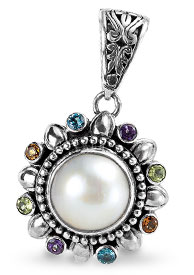MENU
CURRENCY
Named by  as America's best customer service 2025 | 5 Years in a Row
as America's best customer service 2025 | 5 Years in a Row
 as America's best customer service 2025 | 5 Years in a Row
as America's best customer service 2025 | 5 Years in a Row| Shape: | Dome, hemispherical |
| Size Range: | 8.0mm – 15.0mm (average 10.0mm-13.0mm) |
| Colors: | Cream, white, champagne, gold, silver, green, peacock |
| Rarity: | Common |
| Origin: | Australia, Indonesia, Philippines |
| Mollusk: | Silver lipped oyster, Black lipped oyster, Penguin oyster |
| Grow Time: | 2-6 years (depending upon size desired) |

Although Mabe pearls are among the lowest priced pearls, there is an argument as to whether they should be called pearls at all. Because of the process, some believe that they should be called composite pearls since the backing isn't really pearl and there is just a thin dome of nacre.
South Sea Pearls have the same grading system as Freshwater pearls which is as follows:

Excellent luster
Best grade of necklace-quality freshwater pearl
Clean surface of 95% or better
Round to near round shape
Top 1% of freshwater pearls produced
Superior matching

Best grade of Mabe pearl
Mabe pearls appear to be nearly round from a yard away
90% or better of the surface is clean
Matching is good to excellent

Good to average luster
Near round to off-round
Slight surface blemishing is visible on less than 20% of surface
Matching is considered to be good to moderate

Average to low luster
Shape is near round to slightly off-round
Moderate blemishing is present over less than 30% of surface
The matching is considered good to moderate
Mabe pearls come in an amazing range of beautiful pearl colors, which range from light pinks, to more bluish shades. Thanks to the unique nacre of the Mabe oyster, the hues are both rainbow-like and brilliant. Their rarest colors of pink with gold swirls are the rarest colors available. This type of color, as well as their superiority in texture and luster brings a higher value to these pearls. They are very lovely to look at but not near as expensive or valuable as round pearls.






